FREE Nevada DMV Motorcycle Practice Test 2024
The Nevada Motorcycle License practice exam is now available for free. These practice test questions should be written by anyone studying for their Nevada Motorcycle License. All of the questions on this test are answered using the Nevada Motorcycle Operator Manual. Read and reread the guide thoroughly before writing these practice questions. There are 25 questions on the test. All of the questions are multiple-choice, with four different answers to choose from. Consider your response carefully. There is just one correct answer to each question. Read the hints provided for each question if you're having trouble deciding. If you're still stumped, make an educated guess. If you choose correctly, you'll be able to go on to the next question. If you guess incorrectly, the right answer will be displayed along with an explanation. You can take this practice test as many times as you want. You must correctly answer 20 of the 25 questions to pass. If you pass this exam, it is not a guarantee that you will pass the state exam.
1 . When a lead rider's right leg is extended, it means:
Signals are an important part of communication when riding in groups. When the lead rider's right leg is extended, it means there is a hazard in the roadway on their right side.
2 . When traveling in heavy traffic, maintain a minimum ______ following distance.
An expanded cushion of space is needed if your motorcycle will take longer than normal to stop. If the pavement is slippery, if you cannot see through the vehicle ahead of you, or if traffic is heavy and another driver may try to squeeze in front of you, open up to a minimum three-second following distance.
3 . When changing lanes:
Motorcycles have blind spots just like any other vehicle. Always turn your head and look over your shoulder to check for traffic in your blind spot before changing lanes.
4 . What is the best lane position for a motorcycle?
No single lane position is always best and no single lane position should always be avoided. Adjust your lane position as road and traffic conditions change, choosing a position that will maximize your space cushion and allow other drivers to see you more easily.
5 . To cross tracks that run parallel to your lane, you should:
To safely cross trolley tracks, railroad tracks, ruts, or pavement seams running parallel to your lane, move to a lane position that will allow you to cross them at an angle of at least 45 degrees. Then, make a quick, sharp turn. If you try to edge across, the tracks or seam could catch your tires and throw you off balance.
6 . From top to bottom, the following is the proper order for traffic lights:





